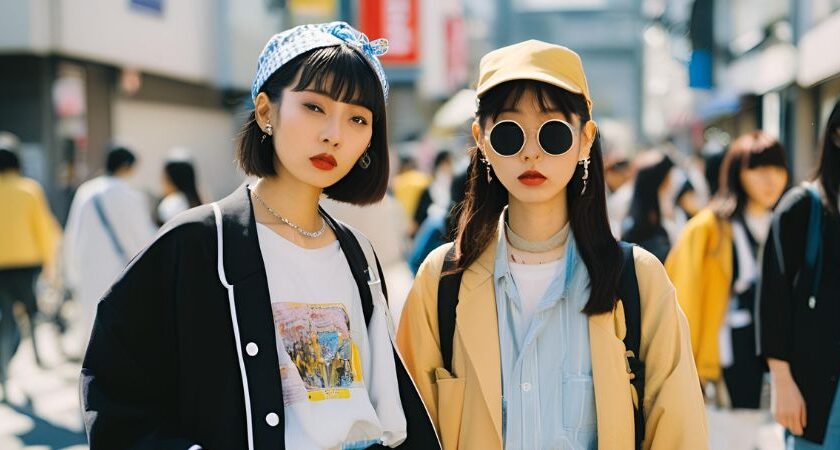Japanese street style fashion is a globally recognized phenomenon celebrated for its eclectic, daring, and highly individualistic approach. Born from the bustling streets of Tokyo, this style embodies creativity, innovation, and a rebellious spirit that has influenced fashion worldwide. From the colorful Harajuku scene to minimalist designs, Japanese street style continues to push the boundaries of fashion.
In this article, we’ll explore the history, key styles, and cultural influences behind Japanese street fashion. Let’s dive into this dynamic world of self-expression.
The Roots of Japanese Street Style Fashion
Japanese street style fashion has deep historical and cultural roots. To fully appreciate its vibrant essence, it’s essential to understand its evolution.
1. Post-War Japan and Western Influence
After World War II, Japan underwent a cultural transformation. Exposure to Western culture introduced new trends and ideas, especially in the realms of music and fashion. Japanese youth began experimenting with Western styles, combining them with traditional Japanese elements. This period marked the birth of a unique fashion movement.
2. The Rise of Harajuku
In the 1970s and 1980s, the Harajuku district in Tokyo became a hub for youth culture. Teenagers flocked to its streets, expressing themselves through bold and unconventional outfits. This era solidified Harajuku as the epicenter of Japanese street fashion, a reputation it still holds today.
Key Styles in Japanese Street Fashion
Japanese street fashion isn’t a monolith. It encompasses a variety of subcultures, each with its own distinct identity. Let’s explore some of the most popular styles.
1. Harajuku and Decora
- Harajuku Style: Known for its playful and colorful aesthetic, Harajuku fashion often features layered outfits, unique accessories, and a mix of Western and Japanese influences.
- Decora: A substyle within Harajuku, Decora focuses on maximalism. Outfits are adorned with vibrant accessories, hairpins, and stickers, creating a whimsical and youthful vibe.
2. Lolita Fashion
Lolita fashion draws inspiration from Victorian and Rococo eras. It’s characterized by frilly dresses, petticoats, and delicate lace details. Subcategories include:
- Sweet Lolita: Pastel colors and playful motifs.
- Gothic Lolita: Darker tones with dramatic, gothic influences.
- Classic Lolita: A more mature and understated take on the style.
3. Visual Kei
Rooted in the Japanese music scene, Visual Kei is a dramatic and theatrical style that blends punk, goth, and glam rock elements. Outfits often feature heavy makeup, elaborate hairstyles, and edgy clothing.
4. Gyaru
Gyaru, meaning “gal,” emerged in the 1990s as a rebellion against traditional Japanese beauty standards. Known for its tanned skin, voluminous hair, and bold makeup, Gyaru represents a confident and carefree lifestyle.
5. Minimalism and Normcore
Not all Japanese street fashion is extravagant. Minimalist styles have gained popularity, focusing on clean lines, neutral tones, and high-quality materials. This approach is often associated with the Japanese philosophy of “wabi-sabi,” which values simplicity and imperfection.
Cultural Influences Shaping Japanese Street Fashion
Japanese street style isn’t just about clothing; it reflects deeper cultural values and societal trends.
1. The Role of Individualism
In a society known for its emphasis on conformity, street fashion offers an outlet for self-expression. Young people use fashion to showcase their individuality and challenge societal norms.
2. Influence of Pop Culture
Anime, manga, and J-pop have a significant impact on Japanese street style. Characters and celebrities often inspire fashion trends, leading to a seamless blend of fiction and reality.
3. Craftsmanship and Attention to Detail
Japanese fashion places a strong emphasis on craftsmanship. From intricate embroidery to high-quality fabrics, attention to detail is a hallmark of Japanese streetwear. This dedication elevates even the most casual pieces into works of art.
Global Influence of Japanese Street Style
Japanese street fashion has captivated the world, influencing designers, artists, and trendsetters globally.
1. High Fashion Meets Streetwear
Luxury brands like Comme des Garçons and Yohji Yamamoto have drawn inspiration from Japanese street style. These designers blend avant-garde elements with streetwear aesthetics, creating a unique fusion of high and low fashion.
2. The Kawaii Movement
The global fascination with “kawaii” (cute) culture has its roots in Japanese street fashion. From pastel colors to playful accessories, this trend has been embraced worldwide, especially in pop culture and social media.
How to Embrace Japanese Street Style Fashion
If you’re inspired to incorporate Japanese street fashion into your wardrobe, here are some tips to get started:
1. Experiment with Layers
Layering is a key aspect of Japanese street style. Mix and match different textures, patterns, and lengths to create a dynamic look.
2. Invest in Statement Pieces
Unique accessories, bold shoes, or an eye-catching jacket can transform an outfit. Look for pieces that showcase creativity and individuality.
3. Combine Traditional and Modern Elements
Incorporate traditional Japanese items like kimonos or geta sandals into contemporary outfits for a distinctive look.
4. Stay True to Yourself
Japanese street fashion is all about self-expression. Don’t be afraid to break the rules and create a style that reflects your personality.
FAQs
What is Japanese street fashion called?
Japanese street fashion is not a single term but encompasses various styles such as Harajuku, Lolita, Visual Kei, Gyaru, and more. It reflects individuality, creativity, and a mix of traditional and modern influences.
What is the fashion street in Japan?
Harajuku, located in Tokyo, is the most famous fashion street in Japan. Known for its vibrant culture and unique styles, Harajuku is a global hub for experimental and diverse street fashion trends.
How to dress Japanese street style?
To dress Japanese street style:
- Experiment with layers and textures.
- Combine bold prints with neutral basics.
- Incorporate unique accessories or statement pieces.
- Mix traditional elements, like kimono fabrics, with modern items.
- Stay authentic to your personal expression.
Why is Japanese streetwear so popular?
Japanese streetwear is popular because of its unique blend of craftsmanship, individuality, and innovative designs. It challenges traditional norms, offering bold and experimental styles while maintaining exceptional attention to detail, making it globally influential.
What is unique about Japanese fashion?
Japanese fashion stands out for its emphasis on individuality, high-quality craftsmanship, and the seamless fusion of traditional and modern elements. From minimalist aesthetics to bold, avant-garde styles, Japanese fashion embraces diversity and creativity.
What made streetwear popular?
Streetwear became popular due to its roots in youth culture, music, and art. It blends casual wear with luxury elements, offering accessibility and exclusivity. Japanese streetwear brands like A Bathing Ape and Neighborhood further elevated its global appeal through unique designs and collaborations.
Conclusion
Japanese street style fashion is more than just a trend; it’s a cultural movement that celebrates individuality, creativity, and craftsmanship. From the vibrant streets of Harajuku to minimalist aesthetics, Japanese fashion continues to inspire and influence the global fashion scene.
Whether you’re a fan of bold Decora styles or sleek minimalist designs, there’s something in Japanese street fashion for everyone. Embrace the spirit of experimentation and let your personal style shine.



